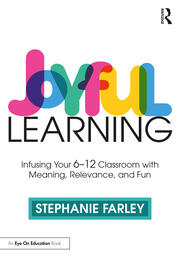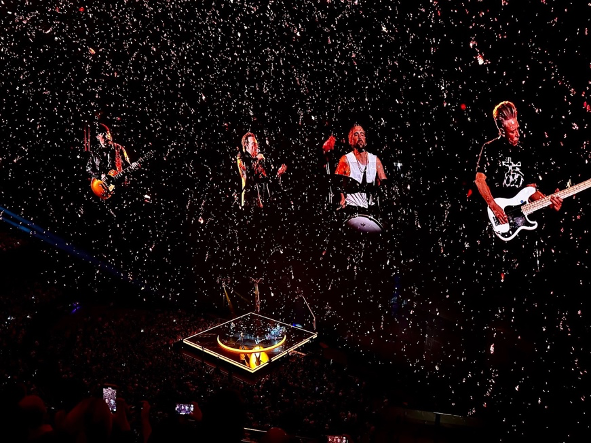“Savoring” Can Be an Incredible Learning Tool
By Stephanie Farley
 Not long ago I had the good fortune of attending a U2 concert at the Sphere in Las Vegas. I don’t know if you’ve heard about the Sphere, but it is an orb-shaped event venue covered ceiling to floor in gigantic, high resolution screens. It’s truly a new level of immersive entertainment.
Not long ago I had the good fortune of attending a U2 concert at the Sphere in Las Vegas. I don’t know if you’ve heard about the Sphere, but it is an orb-shaped event venue covered ceiling to floor in gigantic, high resolution screens. It’s truly a new level of immersive entertainment.
Before the show even started, the screens were cosplaying as the Pantheon in Rome. You could see the famous repeated square pattern of the Pantheon dome, as well as a “hole” in the ceiling that allows one to see “outside.” There was even an image of a stray bird flapping about the hole, as though it had flown inside!

Ever since the concert, I’ve been like the happy version of the Ancient Mariner, seeking a way to tell my story of the show to every person I talk to. For example, a colleague was chatting about index cards needed for a class project:
“Speaking of magic,” I jumped in, “have you been to Vegas recently and seen the Sphere? No? Well, I went to U2 there and it was incredible! Are you a U2 fan? You gotta go! They added January dates!”
This led to a 5-minute recounting of my experience at the Sphere, including detailed sensory imagery.
Harnessing the power of savoring
By retelling my U2 story, of course, what I’m really doing is savoring. Savoring is the act of rekindling and re-experiencing the positive emotions associated with a past event. A construct of positive psychology, savoring often happens at an unconscious level; in those cases, we tend to call it reminiscing or remembering.
However, it’s possible and even preferable to harness the power of savoring to improve your sense of well-being and to reframe past events in a positive light. You may be familiar with this phenomenon if you’ve ever been on a vacation that felt full of obstacles as you experienced it in real time, but, once some time passed, you were able to tell the story of that ill-fated vacation as a comedic tour de force.
Savoring is an incredible tool in the middle school classroom. At this critical juncture of life – before the full-on snark of teenagedom begins and the golly-gee-whiz-ness of childhood recedes – reminding adolescents that they can recall past events and experience positive emotions right now is a powerful pathway not just to an improved sense of well-being, but also to increased focus and self-regulation.
This emotional and mental lift, in turn, leads to a greater willingness and capacity to learn. In other words, it’s well worth your time to subtly teach your students to savor!
Options for savoring in day-to-day teaching
1. As an opening activity, ask students to tell a quick story about the last time they said, “whoa”…an unscientific yet fairly reliable measure of awe. Prompt students with your own story of being awed by nature, music, art, or an inspiring person. Encourage students to add a sensory detail, which helps the memory come alive.
I’m an English teacher, so of course I’d have students write after this, but if you’re a science teacher, connect the kids’ stories of awe to the awesomeness of the periodic table or the marvel-inducing nature of seeing a cell under a microscope.
2. Ask students to reflect on the best time they’ve ever had in a _____ class (fill in the blank with your subject). Have them get super specific about the details…what exactly did they do? What did they say? What did the teacher say? What did their classmates do and say?
See if they can isolate what made the class special. Then, ask students to engineer/design a period of your class with the goal of inducing positive vibes. The plan that brings the most joy and learning to the most people can be implemented at your discretion.
3. Add savoring to a reflection on academic performance. Hopefully you’re already having students reflect on what they learned at the end of each grading term. Include a question about “what was the best project or lesson we did this trimester? Why?”
This simple question helps students to look back on their experiences as not just a litany of things that went wrong, but what went well. To really enhance the savoring feeling, do this as an out loud activity with the entire class.
4. As the year progresses, allow class-specific reminiscences under the umbrella of savoring. “Mrs. Farley, do remember when you fell off your chair that time? And you started laughing? That was fire…” is an acceptable conversation starter because it helps us all remember warm feelings of community and broad physical humor.
5. At the beginning of class, ask students what their favorite math problem has been so far this year, or their favorite experiment or their favorite historical moment. We don’t often ask students to isolate preferred moments from the classes we’ve just conducted, but doing so encourages savoring.
Of course you’ll get some smart-aleck answers, but that’s okay. Enough kids will be pleasantly surprised by your question that they’ll want to answer sincerely.
Savoring is supported by recent research
I recognize that savoring doesn’t seem that powerful or useful. In fact, it can come off as ludicrous – like I’m advising you to build a dam with a handful of paper straws. However, there is ample research to support the positive impact of savoring on all sorts of populations, from the neurotypical to the neurodiverse to the emotionally fragile.
One of the pioneering researchers in the field, Fred Bryant, recently wrote that, “Savoring capacities may also serve as a protective factor for people who have difficulties regulating negative emotion. Supporting this notion, there is evidence that the ability to savor buffers the relationship between poor coping skills and higher symptoms of anxiety” (Bryant 11).
While we aren’t in the business of offering psychological services to students, as teachers we do wish to create a warm, nurturing, positive environment for learning. Intentionally including savoring helps us construct that environment.
Also consider this research done by Mary Helen Immordino-Yang, a former 7th grade science teacher turned brain researcher. She and her colleagues suggest that the key mechanism by which adolescents learn and make meaning is through storytelling in a social emotional context (Immordino-Yang and Knect 8). So…savoring is a form of storytelling that aids learning! Wins all around!
As you think of other ways to squeeze savoring into your class routines, I’m going to find a new person I can talk to about the U2 concert. Let the good times roll!
Works Cited
Bryant, FB. “Current Progress and Future Directions for Theory and Research on Savoring.” Frontiers in Psychology. 12:771698, 2021. doi: 10.3389/fpsyg.2021.771698
Immordino-Yang, Mary Helen and Knect, Douglas R. “Building Meaning Builds Teens’ Brains.” Educational Leadership, Volume 77: May 2020.

Stephanie’s first book is Joyful Learning: Tools to Infuse Your 6-12 Classroom with Meaning, Relevance, and Fun (Routledge/Eye On Education, 2023). She has created professional development for schools around reading and curriculum and coaches teachers in instruction, lesson planning, feedback, and assessment. Visit her website Joyful Learning and find her other MiddleWeb articles here.






































This was fun to read!